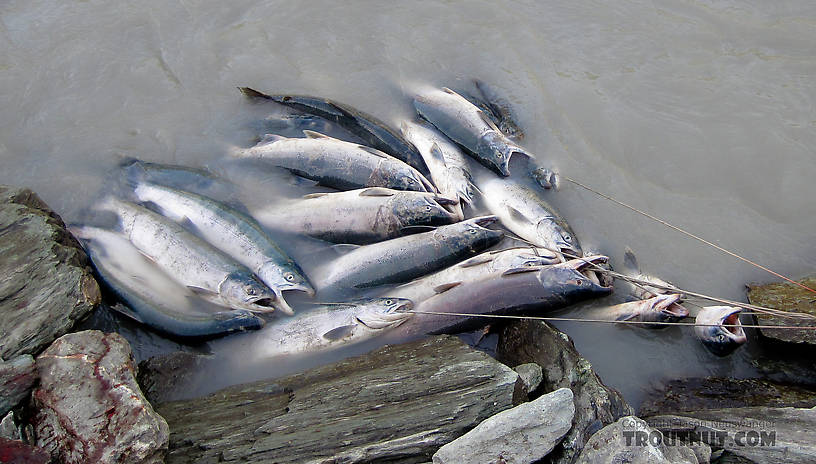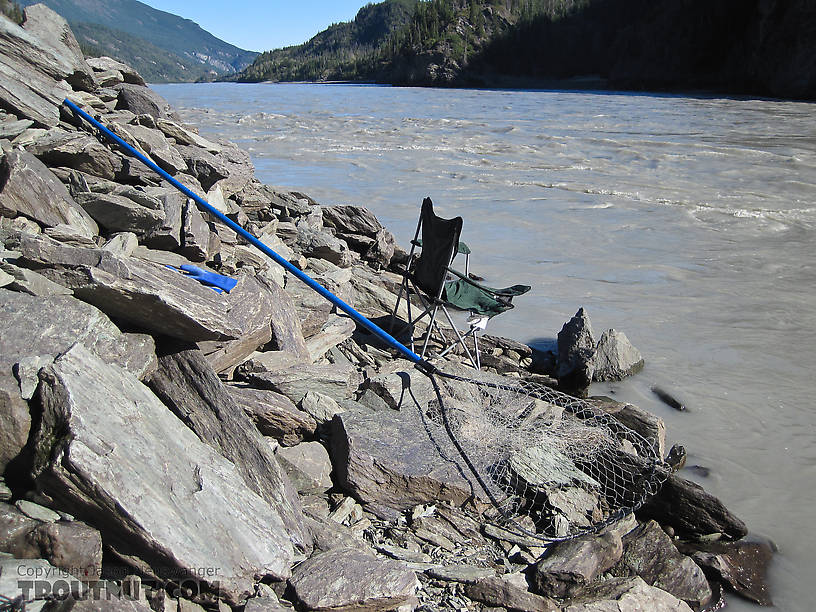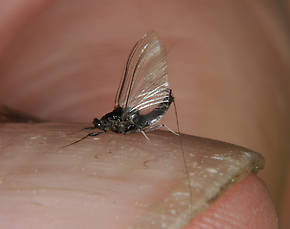Blog & Latest Updates
Fly Fishing Articles
Insects by Common Name


Dipnetting for sockeye salmon in the Copper River at Chitina, Alaska
One of the perks of being an Alaska resident is that we can partake in several "personal use" fisheries that allow dip-netting for salmon. With harvest limits of up to 40 fish, they make it possible to have salmon as a staple of our diets, which we could never do by sport angling because of the 3-fish possession limit and the 10-hour round trip drive required to reach a decent salmon stream from Fairbanks. The crown jewel of Alaska's dipnetting sites is the sockeye salmon fishery at in the Copper River at Chitina. The salmon passing through here are very possibly the best-tasting fish in the world. Fed on plankton in the clean waters of Prince William Sound and the Gulf of Alaska, they stockpile unusually large amounts of tasty, healthy fatty acids in their firm, red flesh. The longer a salmon has to travel to reach its spawning grounds, the more fat it stores, so the tastiest salmon are those caught near the beginning of a journey up a very long river like the Copper or the Yukon.
Although "sporting" is the wrong word for dip-netting, it's much more challenging than most would expect. When I first heard about it, I pictured relaxed Alaskans standing on the bank of a clear, mid-sized river, nets laying on the ground as they watch and wait for salmon to appear. I had not imagined the thundering slurry of powdered mountain that is the Copper River at Chitina, a river the size of the Missouri squeezing through a bedrock canyon 100 meters wide. Most of the water is glacial melt, no clearer than chocolate milk, so densely is it loaded with the dust of the Alaska Range and the Wrangell Mountains. There's no outward sign of the thousands--sometimes tens of thousands--of salmon that pass through every day of the summer, inches below the opaque surface. The dip-netter perches on a narrow shelf of jagged rocks, holding a large net in the river continuously, fighting the force of the silt-laden current from the other end of a 15-foot metal pole. The telltale bump of a salmon in the net may come every few minutes, or hours apart, and I have spent (Spent: The wing position of many aquatic insects when they fall on the water after mating. The wings of both sides lay flat on the water. The word may be used to describe insects with their wings in that position, as well as the position itself.) about 12 hours on the net each year to obtain my limit. It's hard work to fill the freezer with this world-class delicacy.
Catch & release purists need not cringe at the sight of these photos: the Copper River sockeye salmon fishery is a sustainably managed, hatchery-supplemented fishery with limits and closures adjusted several times throughout the season by the Alaska Department of Fish & Game. The run each year contains more than enough salmon to replenish the population, especially with the hatchery's help, and the excess is split among commercial fishermen in Prince William Sound, native subsistence users who can each catch hundreds of salmon in their fish wheels, dip-netters in the "personal use" fishery, and a comparatively tiny harvest by sport anglers in clearer tributaries, mostly the Gulkana and Klutina rivers. Many of the fish we dipnet in the main stem Copper are destined for off-road tributaries that rarely see an angler, especially not a salmon angler. When someone fishes that far out into this part of the wilderness, they're in pursuit of grayling, dollies, or rainbows, not salmon.
Photos by Troutnut from the Copper River in Alaska

Here's part of my final catch, though many more fish are hidden in the turbid glacial water. There are 40 salmon in all. The limit for a household dipnetting permit is normally 30, but this year the sockeye run greatly exceeded expectations, so the Alaska Department of Fish & Game increased everyone's limit by 10 for several weeks.
StateAlaska
LocationCopper River
Date TakenAug 12, 2011
Date AddedAug 16, 2011
AuthorTroutnut
CameraCanon PowerShot D10

StateAlaska
LocationCopper River
Date TakenAug 12, 2011
Date AddedAug 16, 2011
AuthorTroutnut
CameraCanon PowerShot D10

Dipnetting to fill the freezer with salmon is not as tidy as catch & release fly fishing. Here's the process: 1. Beat the salmon as hard as you can between the eyes with a club, several times if needed, while it's still in the net. This makes it stop flopping so you can remove it from the net. 2. Cut the base of the gill arches on one side with scissors, severing major arteries that send blood spurting out of the unconscious fish's body, quickly killing it and assuring ideal flavor. 3. Thread the stringer in through one of the gills and out the mouth, and stick the fish back in the glacial river to keep cool.
After whacking ten or fifteen fish in the same spot, the riverbank looks like it warrants a CSI team.
After whacking ten or fifteen fish in the same spot, the riverbank looks like it warrants a CSI team.
StateAlaska
LocationCopper River
Date TakenAug 12, 2011
Date AddedAug 16, 2011
AuthorTroutnut
CameraCanon PowerShot D10

I spent twelve hours holding this net in the river, often in fast current. The key is to hold it in an eddy, so it billows out upstream and can catch the salmon that are all swimming in that direction. The eddies along the bank attract salmon because it's easier for them to run upstream with the current than against it. The best eddies are the narrow ones where the rest of the river is flowing fast downstream most of the salmon hug the bank.
StateAlaska
LocationCopper River
Date TakenAug 12, 2011
Date AddedAug 16, 2011
AuthorTroutnut
CameraCanon PowerShot D10

The Copper River is often over a mile wide, but the dipnetting almost all takes place in this narrow canyon below the confluence with the Chitina River. Here the river squeezes into a deep, fast, turbulent rapids that funnels fish through a narrow area and forces them to hug the banks where anglers can reach them.
StateAlaska
LocationCopper River
Date TakenAug 12, 2011
Date AddedAug 16, 2011
AuthorTroutnut
CameraCanon PowerShot D10

I was at a popular spot for dipnetting, and this little rodent (a vole, I think?) hit the jackpot with an earlier angler's leftover snack.
StateAlaska
LocationCopper River
Date TakenAug 12, 2011
Date AddedAug 16, 2011
AuthorTroutnut
CameraCanon PowerShot D10
Closeup insects by Bnewell from the Touchet River in Washington
Male Tricorythodes (Tricos) Mayfly Spinner View 3 PicturesI collected these males about 9:30 AM, air temp. about 68 degrees F. The males were flying about 3 ft above the stream flying up and down the stream rather than the typical vertical swarm you see with most mayfly males. The males are black and the females are a green color due to the eggs they are carrying. They do not live very long which is typical for small bodied mayflies. They do not fly during windy conditions. I suspect these are Tricorythodes minutus.
View 3 PicturesI collected these males about 9:30 AM, air temp. about 68 degrees F. The males were flying about 3 ft above the stream flying up and down the stream rather than the typical vertical swarm you see with most mayfly males. The males are black and the females are a green color due to the eggs they are carrying. They do not live very long which is typical for small bodied mayflies. They do not fly during windy conditions. I suspect these are Tricorythodes minutus.
 View 3 PicturesI collected these males about 9:30 AM, air temp. about 68 degrees F. The males were flying about 3 ft above the stream flying up and down the stream rather than the typical vertical swarm you see with most mayfly males. The males are black and the females are a green color due to the eggs they are carrying. They do not live very long which is typical for small bodied mayflies. They do not fly during windy conditions. I suspect these are Tricorythodes minutus.
View 3 PicturesI collected these males about 9:30 AM, air temp. about 68 degrees F. The males were flying about 3 ft above the stream flying up and down the stream rather than the typical vertical swarm you see with most mayfly males. The males are black and the females are a green color due to the eggs they are carrying. They do not live very long which is typical for small bodied mayflies. They do not fly during windy conditions. I suspect these are Tricorythodes minutus.Collected August 12, 2011 from the Touchet River in Washington
Added to Troutnut.com by Bnewell on August 12, 2011
Added to Troutnut.com by Bnewell on August 12, 2011
«Older: Driving down the Richardson to Chitina, with a stop at the GulkanaNewer: A couple nighttime pictures of the Gulkana River»
Most recent comments on this post (latest on top)
| GldstrmSam | June 4th, 2013, 3:14 am | |
| Fairbanks, Alaska Posts: 212 | I couldn't help but think what wonderful dubbing I could have made from that little "vole" Hey Spence, I've actually tried to skin a vole for dubbing...I used a scalpel to do it and it was still a REAL pain.(How stupid could someone be:) There has to be a smarter way to do it...:) Can't believe this season has rolled around already! Can hardly wait! Sam | |
| There is no greater fan of fly fishing than the worm. ~Patrick F. McManus | ||
| SalchaPat | June 2nd, 2013, 6:03 pm | |
| Posts: 1 | Hooks & Bullets just made some videos that show newbies how to dip net down in Chitina. Might be good for your forum. There's four of them I think on the Chitina page: http://www.adfg.alaska.gov/index.cfm?adfg=PersonalUsebyAreaInteriorChitina.video | |
| Oldredbarn | September 1st, 2011, 12:30 pm | |
| Novi, MI Posts: 2608 | Jason, Just to let you know you did not offend your vegetarian, catch-and-release buddy down in Detroit, I couldn't help but think what wonderful dubbing I could have made from that little "vole"...March Brown bodies...maybe Henny's...Hmmm. What a useful shade he/she is! ;) Spence | |
| "Even when my best efforts fail it's a satisfying challenge, and that, after all, is the essence of fly fishing." -Chauncy Lively "Envy not the man who lives beside the river, but the man the river flows through." Joseph T Heywood | ||
| Troutnut | August 16th, 2011, 6:50 pm | |
Administrator Bellevue, WAPosts: 2737 | I just added to this day's update, so I'm bumping its discussion. | |
| Jason Neuswanger, Ph.D. Troutnut and salmonid ecologist | ||
Comment on this post
Top 10 Fly Hatches
Top Gift Shop Designs
Eat mayflies.
Top Insect Specimens
Miscellaneous Sites
Troutnut.com is copyright © 2004-2024 Jason
Neuswanger (email Jason). See my FAQ for information about use of my images.
 privacy policy
privacy policy



